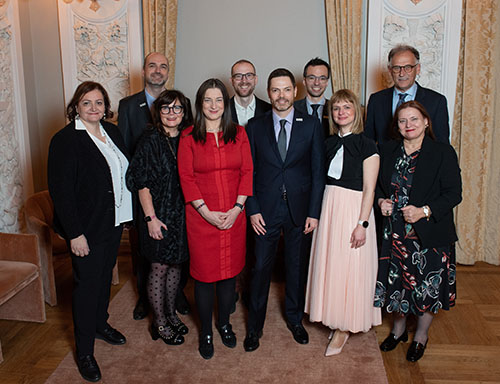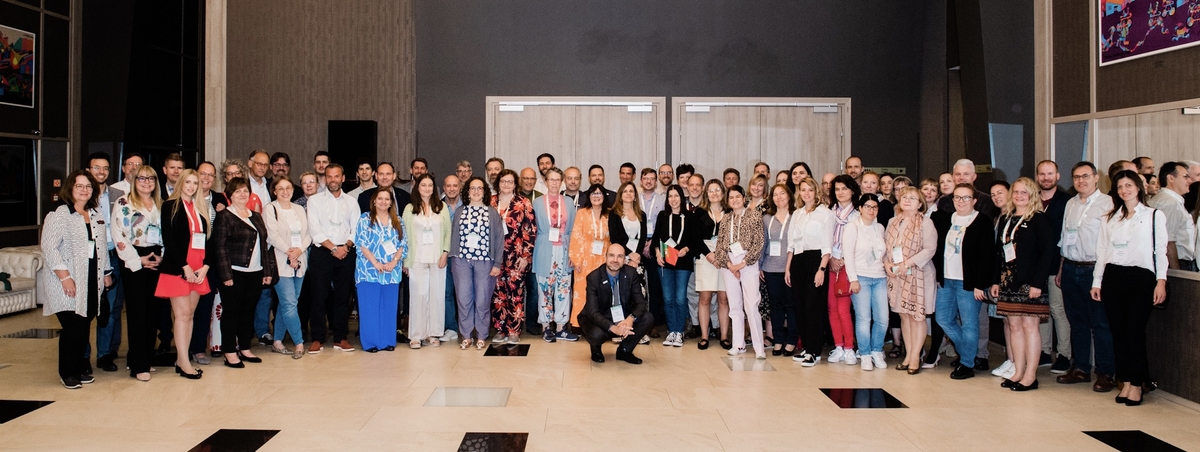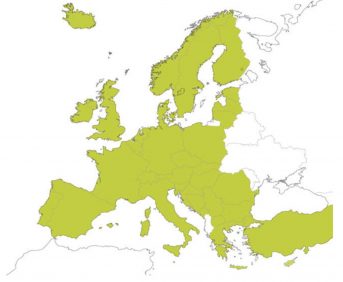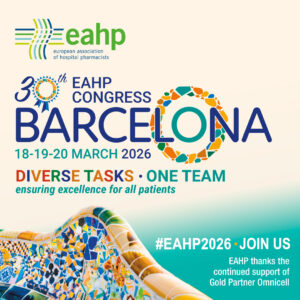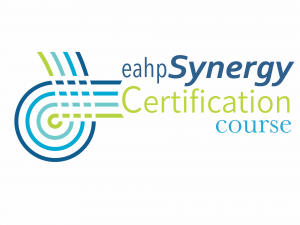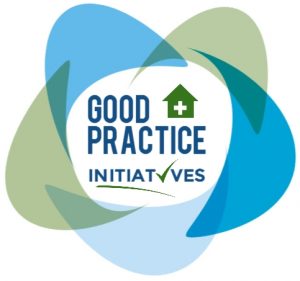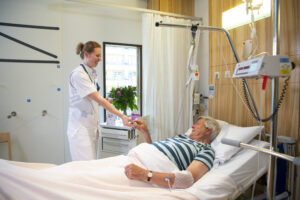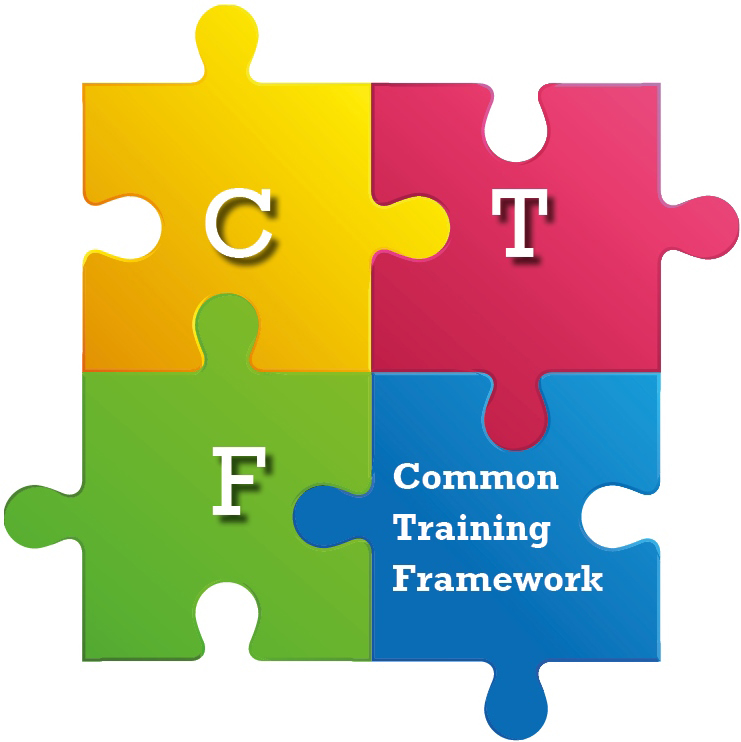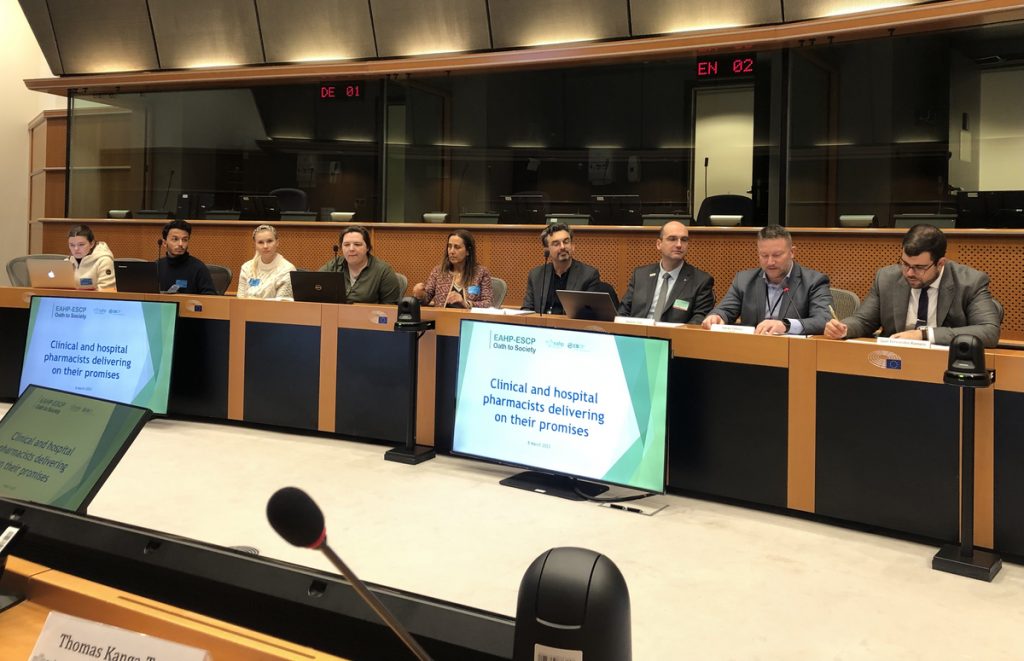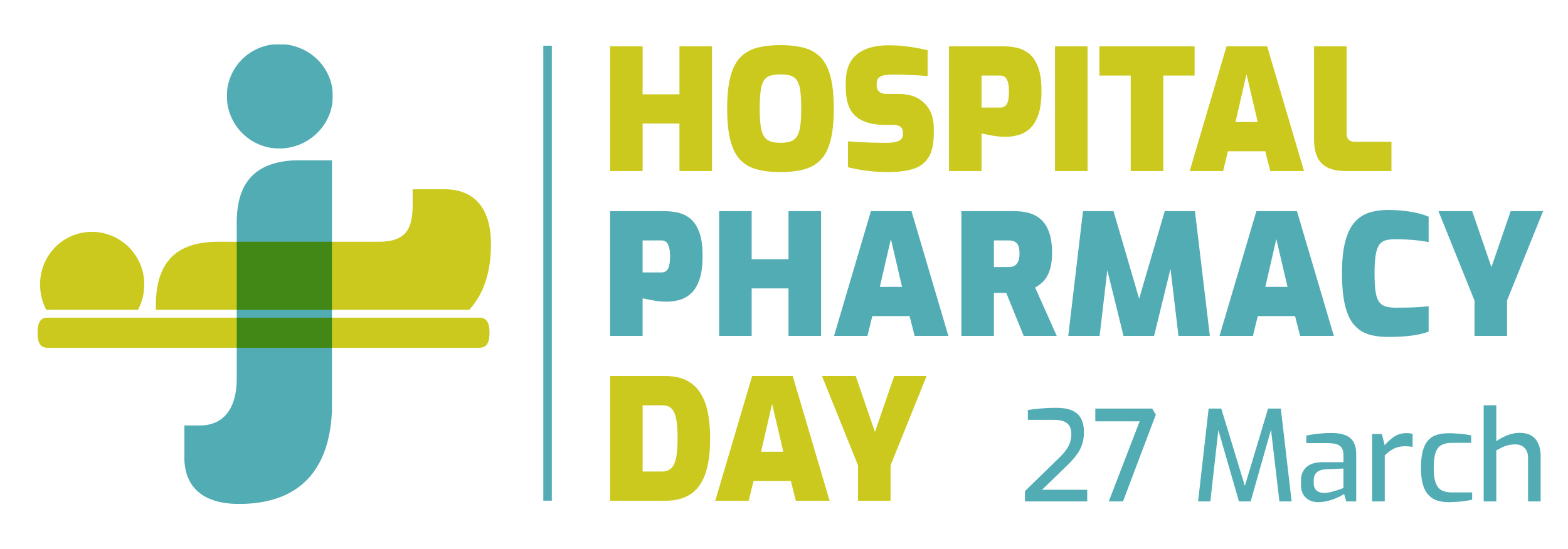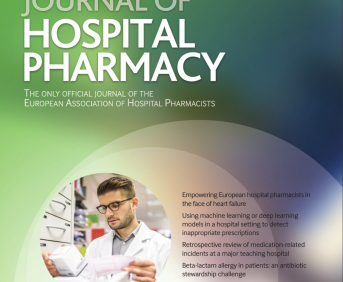Hospital pharmacists’ professional empowerment through skills integration: experience of international cooperation between Italy and Tanzania
Pdf

European Statement
Education and Research
Author(s)
Agnese Bosio, Chiara Carcieri, Sixberth Bugeraha, Silvia Scalpello, Giovanna Fazzina, Maria Carmen Azzolina, Gianluca Miglio, Annalisa Gasco
Why was it done?
Drug dispensing and patient monitoring are institutional activities of hospital pharmacists worldwide. Nevertheless, the enhancement of managerial capabilities, hard and soft skills is crucial to tackle the critical challenge arising from geographical, epidemiological, demographic, cultural and legislative differences between different countries.
What was done?
An initiative for cooperation and interaction between hospital pharmacists from different income countries has been developed.
How was it done?
The initiative was led by a pharmacist from an Italian hospital who was hosted by a hospital in southern Tanzania and spent a month collaborating with local hospital pharmacists, in order to streamline integrated workflows and optimise clinical care outcomes and professional training.
What has been achieved?
A Strengths Weaknesses Opportunities Threats (SWOT) matrix was developed to assess the impact on three main areas: drug management, clinical pharmacy and pharmaceutical care.
Strengths: attitude for workflow standardisation, multidisciplinary and multicultural teamwork, sharing of expertise and best practice, speed up of limiting processes in order to develop activities in support of patients and clinicians, time and effectiveness in qualified staff training.
Weaknesses: complexity of procedures for drug import, hospital staff shortage (both pharmacists and physicians), absence of primary care and hospital-territory continuity of care network, clinical severity of patients admitted to hospital, imbalance between clinical pharmacy/pharmaceutical care in favour of drug management.
Opportunities: professional growth due to new healthcare challenges facing, soft skills improvement (problem solving, versatility, working under stress, teamwork, integration, overcoming prejudices), hard skills enhancement (logistics, international legislation, scientific English), budget optimisation for new investments (equipment/staff), improvement of patient safety and overall level of care.
Threats: language/cultural barriers, variable learning curve and resistance to change, barriers in social/professional relationships, individual variability in adaptation period, different patient perceptions of health and medical care.
What next?
Professional integration of hospital pharmacists from different educational and cultural backgrounds could enhance their ability to address different clinical, environmental and socio-economic issues, with the following outcomes: strengthening the professional pathway; optimising outcomes with consequent cost savings; improving the quality of healthcare for patients.
A state-of-the-art on medical devices in Italian clinical pharmacy practice: results from the Italian Society of Clinical Pharmacy and Therapeutics (SIFaCT) survey
European Statement
Clinical Pharmacy Services
Author(s)
Lorenzo Di Spazio, Daniele Mengato, Andrea Ossato, Vera Damuzzo, Marco Chiumente, Giulia Dusi, Sabrina Trippoli, Andrea Messori, Maria Cecilia Giron, Maria Chiara Silvani, Francesca Venturini
Why was it done?
Pharmacist’s activities on MDs are mainly linked to governance, management and vigilance but little to clinical pharmacy practice. In order to study and develop interventions aimed at optimizing the use and compliance of medical devices on patients, a national survey was conducted to identify the clinical pharmacy experiences already consolidated in this field.
What was done?
Clinical pharmacy activities that demand specialized expertise in medical devices (MD) constitute a relatively uncharted territory for hospital pharmacists. Our aim, through a nationwide survey, was to delineate the clinical responsibilities overseen and handled by hospital pharmacists that necessitate a specific focus on MDs.
How was it done?
A 54-question survey, available from 1 October 2022 to 31 December 2022, was created by a pool of experts from an Italian scientific society (Italian Society of Clinical Pharmacy and Therapeutics – SIFaCT) and shared through Google Forms. The questions, divided into six sections, were related to five clinical areas defined by the working group: surgery room (SR), wound care (WC), vascular access management (VAM), patient education on diabetes treatment technologies (DTT) and MD in oncology and artificial nutrition (ON).
The questionnaire allowed us to define the state-of-the-art of clinical pharmacy on MDs, highlighting the activities and training needs of the participants.
What has been achieved?
We received 142 responses. In particular, emerged that 42% of participants adopted standard kits in the SR and 76% of them declared the pharmacist involvement.
A specific team for WC was created for 35% of participants, with the involvement of the pharmacist in 90% of cases, in particular as consultant role in 22%.
37% of participants declared the presence of a team dedicated to VAM, with the involvement of the pharmacist in 40% of cases and patient counselling in 9%. Finally, in DTT and ON the pharmacist was involved in 8% and 10% of the responses, respectively.
What next?
This first national survey shows that the pharmacist is often involved in multidisciplinary groups in the five analyzed areas, but less involved in patient’s counselling probably due to the sub-optimal training in the field of MDs. Indeed, almost all the participants declared the need to improve their knowledge in this field and create a network among colleagues.
Can my medicine be returned to the refrigerator? Minimisation of wastage in case of storage incidents of cold-chain homecare medications
Pdf

European Statement
Clinical Pharmacy Services
Author(s)
Hilde Omestad, Maria Grønkjær Abrahamsen, Fatima Afif Mouaanaki, Charlotte Mosbæk Dybdahl, Anne Wulff Petersen, Emil Dalsgaard Züricho, Philip Hojrizi, Charlotte Arp Sørensen
Why was it done?
The sustainability strategy of the Central Denmark Region include less consumption and less waste. Our Pharmacy delivers an increasing amount of high-cost homecare medications, requiring refrigerator storage. In case of an accidental temperature exposure, patients may ask whether their medicine can be used or not. There may be a delay during transport or a breakdown of their refrigerator at home. During these medicines’ shelf-lives, most products can be kept at room temperature for days, weeks or months. When SmPC and the insert package leaflet says that the product should not be returned to the refrigerator, high-cost medicines sometimes are wasted, only because of this warning, instead of giving them a shorter shelf-life. When we hesitate to return packages to the refrigerator, time can elapse while waiting for the manufacturer’s or pharmacist’s answers to the patient’s questions after storage incidents.
What was done?
The Hospital Pharmacy categorized 47 Blood Coagulation Factors and Monoclonal Antibody Products requiring storage at 2-8 °C if Summary of Product Characteristics (SmPC) had any warning of returning a product to the refrigerator or not, after an unwanted time at room temperature
How was it done?
We asked manufacturers if a return of their product to the refrigerator would cause any harm. Should their product be disposed of because it has been put back into a refrigerator after being left out? Our findings were documented in a local guideline and in the Danish national information database (SAID).
Drug Information Pharmacists discussed several cases of real-world handling situations to be more confident to reduce medicine wastage.
What has been achieved?
Being aware of the reasons for these warnings, reduced medicine wastage in certain cases of incidental storage. The pharmacists have been given tools for pharmaceutical professional assessments in cases of temperature challenges.
What next?
Spread the good news. Improve communication between manufacturer and pharmacy, because manufacturer can’t be responsible for storage different from their SmPC. Inspire manufacturers to improve their storage warnings in SmPC
Too good to go – sharing medication near expiry with a digital solution
Pdf

European Statement
Clinical Pharmacy Services
Author(s)
Charlotte Sørensen, Karin Aagot Møller Jørgensen, Anne Grethe Nørgaard Kyndi, Charlotte Lund Madsen, Line Scriver Poulsen, Charlotte Hjorth, Gitte Slyngborg Morbjerg, Janni Østergaard Jensen, Mette Juul-Gregersen, Rune Dalsenni Rask
Why was it done?
A sustainability project in 2020 highlighted manual and time-consuming workflows when checking expiry dates in hospital medicine rooms. For example, manual reading, interpretation and notation of expiry dates in paper forms every half year. Therefore, a smartphone application was developed and implemented in a large university hospital in 2022. The application was a huge success and colleagues from other Clinical Pharmacy departments in other hospitals within the same region wanted to be part of the success of the initiative.
What was done?
A smartphone application for managing expiry dates in medicine rooms was applied in one hospital in 2022 and in four other hospitals in 2023. The data-matrix of medicine packages is scanned with a smartphone camera and the application gives a sorted overview of medication near expiry. In the application you can register a medicine package as either used, discarded or released. By releasing medicine packages, the medicine is made available to colleagues in other medicine rooms.
How was it done?
The smartphone application was implemented in Clinical Pharmacy departments in four other hospitals, one by one from February 2023. After implementation the application is used in 373 medicine rooms.
What has been achieved?
Clinical Pharmacy staff are happy with the application. It takes significantly less time to check and scan expiry dates with the digital solution.
From February to September 2023 (five hospitals)
• 47491 packages were scanned
• 5251 packages were released (11%)
• 2664 packages were moved between medicine rooms to avoid medicine wastage (51%; 147000 €). Most activity (78%) was seen at the hospital that had been using the application since 2022. Most packages were moved between medicine rooms at the same hospital; however, in 215 cases (8%), medicines were exchanged between hospitals as well (20.000 €)
• 10918 packages were discarded due to expiry (743168 €; 0.5% of bought medicine).
What next?
The full potential of the digital solution remains to be achieved.
Pharmaconomists have to release medicine in the application a few months earlier than they do now. To go shopping in the application before ordering from the pharmacy, will probably also result in discarding less medicine. Sharing medication across hospitals to a greater extent will also be relevant to consider.
Assessing patient behaviour after calling a drug information telephone centre (MiS): what impact on the proper use of medicines?
European Statement
Clinical Pharmacy Services
Author(s)
Vanessa Gomes, Jonathan De Gregori, Greta Dusabe, Hélène Feyeux, Cyril Boronad
Why was it done?
MiS is a telephone service that provides free, reliable information about medicines to all patients and their caregivers. Requests are handled by experienced hospital pharmacists. It is important to know how patients behave after calling MiS in order to assess the benefits of this service on the proper use of medicines.
What was done?
The aim of this study was to assess patients’ behaviour regarding their medication after calling the MiS.
How was it done?
After prior agreement, patients were called back 7 days later to answer a specific survey including six questions: Was the medication changed after the call? Did the patient follow the advice of the MiS pharmacist? Did the patient consult a doctor? or another source of information? Did the patient feel that their health had improved? What are the benefits of this service?
What has been achieved?
Between 2024/03/05 and 2024/03/18, 20 callers completed the survey (65%). Most questions concerned drug interactions (48%), followed by side effects (22%), drug stability (7%), administrative information (7%), indications/contraindications (7%), product availability (3,%), proper use (3%) and dosage (3%). Thanks to the advice of MiS pharmacists, 47% of callers started taking their medication: half of these were prescribed by their doctor and the other half self-administered. Around a third of treatments were continued without change, while 6% were modified. Finally, 12% of treatments were discontinued because of side effects. After calling MiS, 15% of patients consulted a doctor and 15% consulted other sources of information (neighbours, health professionals, etc.). More than half of the patients felt that their health had improved after calling MiS. Lastly, 70% of patients described MiS as safe, 40% as accessible, 35% as available and 30% as a time-saver.
What next?
The demand for MiS shows that patients are looking for more information about their treatments, even if they have already consulted a healthcare professional. The number of treatments prescribed by the doctor that were only initiated after the call also illustrates the benefits of the MiS service. It is an additional service that can reassure callers and contribute to the proper use of medicines by conveying a positive image of treatments and information suited to callers’ knowledge.
Green Team clinical pharmacy and pharmacology of a university hospital in the Netherlands: towards sustainable clinical pharmacy
Pdf

European Statement
Clinical Pharmacy Services
Author(s)
Patricia Van den Bemt, Thijs Oude Munnink
Why was it done?
Healthcare is responsible for an important part of the carbon footprint and medication production and use contribute substantially to this footprint. In line with Green Teams being established in all layers of society at the moment, the UMCG departments were also starting to implement such teams. The CPP was among the first departments establishing such a Green Team in order to reduce the footprint of medication use.
What was done?
The department of Clinical Pharmacy and Pharmacology (CPP) is responsible for providing pharmaceutical patient care to all hospitalised and ambulatory patients of the University Medical Centre Groningen (UMCG) in tThe Netherlands. Two years ago, the department has established a Green Team, dedicated to making this pharmaceutical care as sustainable as possible.
How was it done?
The Green Team CPP started in June 2021 with a brainstorm on potential subjects. As the main focus we chose to ‘contribute to sustainable medication use and to reduce disposal’. The team consists of representatives of all CPP sub-departments. Proactive measures and projects were defined, but increasingly the Green Team is being consulted by doctors and nurses regarding issues on sustainable medication use. Department-wide awareness is fuelled by a periodic newsletter.
What has been achieved?
Three projects were conducted: 1) Switching from paracetamol intravenous therapy to oral/rectal therapy (based on doctor’s question); 2) Patient’s own medicine use combined with self-administration of medication (POM/SAM project; based on nurse question); 3) Exploring oral anticancer drug waste by patient interviews (in preparation of improvement measures; proactive Green Team project). The results of these projects are of interest to all European hospital pharmacists and can inspire others to establish Green Teams to contribute to sustainable pharmaceutical care.
What next?
Given the success of the paracetamol project, we will expand this to other intravenous medications. The pilot project on POM/SAM has inspired us to implement POM/SAM within all nursing departments of the UMCG. And the results of the interviews on oral anticancer waste form a solid justification of the necessity of implementation of re-use of medication. In addition, we will continue to perform new proactive projects, aimed at deprescribing (by performing medication reviews), improving medication adherence, optimising the logistics of medication (reducing the amount of medication being dispensed, implementing of ready to administer medication, implementing of pharmacy IV service), reducing medication and financial waste using vial rounding, and proper disposal of medication. We will also continue to be the expert group to which doctors and nurses can direct their questions on sustainable medication use.
Stratification of psoriasis patients according to pharmaceutical care needed using the capacity-motivation-opportunity pharmaceutical care model
Pdf

European Statement
Clinical Pharmacy Services
Author(s)
NOELIA VICENTE-OLIVEROS, CARMEN PALOMAR FERNANDEZ, TERESA GRAMAGE-CARO, PAULA BURGOS BORDEL, MARÍA DEL CARMEN CALATAYUD SÁNCHEZ, SANDRA CASADO ANGULO, ANA MARTÍN ÁLVARO, MARÍA BEGOÑA RIVERA MARCOS, SONALI KARNANI KHEMLANI, MANUEL VELEZ-DIAZ-PALLARES, ANA ALVAREZ-DIAZ
Why was it done?
Patients with moderate-severe psoriasis require systemic hospital-dispensed treatments. Hospital pharmacists look for actions to anticipate patients’ needs for achieving health outcomes and the system’s sustainability.
What was done?
We stratified psoriasis patients according to the pharmaceutical care needed and established their pharmaceutical care plan. We calculated the time needed in pharmaceutical care after stratification.
How was it done?
An observational, prospective, cross-sectional study was conducted in a university hospital. One hundred psoriasis patients who received medication in the outpatient hospital pharmacy were randomly chosen between March-May 2022.
Capacity-Motivation-Opportunity (CMO) pharmaceutical care model (SEFH, 2018) was used to stratify patients. This model consisted of 23 variables (demographic, clinical, pharmacological, socio-sanitary, cognitive and functional). Each variable scored between 1-4, depending on patient risk. Patients were classified on three levels which determined the subsequent pharmaceutical care to be provided to each patient:
1. global score≥31 points,
2. 18-30 points and
3 ≤17 points.
Information was collected through patients’ interviews and electronic health records review.
A group of nine pharmacists were set up to adapt the CMO pharmaceutical care model to our hospital.
Total time spent in pharmaceutical care was obtained through patient visits before and after stratification. The scheduled average time for each visit was 10 minutes. The number of visits pre-stratification was the sum of all the visits scheduled for the patients, and for post-stratification was the sum of all the visits with the new CMO model (level 1 (biannual), 2 (annual), 3 (as needed).
What has been achieved?
Most patients were stratified on level 3. A pharmaceutical care plan has been designed to meet the needs of each patient.
Stratification has improved the time pharmacists have to accomplish the needs of each patient (16.3 hours/year (98 visits)). Sixty-two percent of patients had as needed visits (level 3), 36% needed annual visits (level 2) and 2% biannual (level 1). However, during pre-stratification, most the patients (70%) had every nine months visits, 18 % every 12 months, 9% every six months and 3% every three months.
What next?
We will expand the stratification to the rest of the psoriasis patients and other outpatient pathologies.
We will coordinate strategies with Social and Psychological Services, Primary care and Community pharmacy to improve pharmaceutical care.
Setting in situation of pharmaceutical validation of paediatric intensive care prescriptions by fifth year students: state of play and assessment
Pdf

European Statement
Education and Research
Author(s)
Omar HANAFIA, Pierre BERTAULT-PERES, Stéphane HONORE
Why was it done?
This internship was proposed to diversify the clinical pharmacy internship opportunities and to allow students to discover and understand paediatrics and intensive care, which are less covered in university courses. It will also be a proof of concept to develop this type of internship in other departments.
What was done?
We have proposed a new clinical pharmacy internship in immersion in paediatric intensive care to 5th year students. It is a hospital internship at the interface between the medical and pharmaceutical teams, the student is responsible for establishing a statement to analyse the drug management, its evaluation and improvement.
How was it done?
The clinical pharmacy student is a full-time employee, fully integrated into the medical team. Their day is divided into two parts: in the morning they attend the relief, the staff and the medical visit. In the afternoon, he/she takes over the patients, compiles the main medical, clinical and biological information in order to pharmaceutically prevalidate the medical prescriptions and propose pharmaceutical interventions (PI) to the pharmacist.
What has been achieved?
Since its opening, the position has been systematically chosen by the students, in 3 years 8 students have chosen it. After a training period of 1 month with the senior pharmacist, all students were able to perform the expected readings, prevalidation and PI. More than 78% of the PIs detected by the students were validated by the senior pharmacist and accepted by the physician.
What next?
This proof of concept shows that students are supportive of this type of initiative and are able to meet the high expectations of this internship.
Implementation of a clinical pharmaceutical service for ostomates
Pdf

European Statement
Clinical Pharmacy Services
Author(s)
Iris Summer, Marina Zakhari-Betros, Alice Poier, Christine Fegerl-Stadlober
Why was it done?
There had been reports from healthcare professionals of the presence of undigested tablets in ostomy pouches and reasonable doubts of adequate drug absorption. In addition, there were recurring inquiries from clinicians about drug related problems in ostomy-patients.
What was done?
Implementation of a clinical pharmaceutical service for patients with an intestinal ostomy following their stoma-surgery. In this service, oral drug therapy of patients with either ileostomy or colostomy was assessed to determine whether possible impairment of drug liberation or absorption could lead to malabsorption of drug therapy.
How was it done?
A project was conducted, where 30 ileostomy and colostomy patients were observed. Simultaneously, a literature review concerning all orally administered drugs of this patient collective was done. During the project time, two interviews were done with the patients. The first one was lead during hospitalisation whereas the second one was conducted within 4 weeks after hospital discharge. To standardise the interviews, two different questionnaires were developed. Medical status of the patient as well as pharmacokinetic properties of the drugs administered orally were thus assessed. It was evaluated whether there are any drugs which may feature any impaired drug liberation or absorption. In case of anomalies presented, such as undigested tablets found in the pouch, a plasma level measurement of the drug was done, if reasonable. In addition, the subjective perception of the patients was also taken into account, to measure whether malabsorption of drugs is recognised or not and if patients are aware of possible impairment of absorption.
What has been achieved?
A strategy was established to help healthcare professionals assess oral drug therapy in ostomates. In addition, awareness in healthcare professionals as well as patients was raised, concerning possible impaired drug liberation because of the use of inappropriate dosage drug form. Moreover, prevention of prospective drug related complications was also achieved.
What next?
1. Modification of our electronic medical record concerning automated pharmaceutical counselling.
2. Integration of a clinical pharmaceutical service within the ostomy care service of our hospital to provide better therapeutic outcome, especially when ostomy-related problems are presented.
3. Providing patient information leaflets to improve health literacy and patient satisfaction.
App PharmaClick
Pdf

European Statement
Clinical Pharmacy Services
Author(s)
Catarina da Luz Oliveira, Maria Augusto, Carla Ferrer
Why was it done?
Ideally, clinical pharmacy should be performed continually and not only at the Pharmaceutical Consultation. The usage of technologies as new communications channels between patients and pharmacists would contribute to this notion of continuous clinical pharmacy, so we started to develop the app PharmaClick. With this app, the pharmacist will be able to remotely monitor the patient therapy, to mitigate medication errors, to control adverse drug reactions, to detect possible drug interactions, and to promote therapy adherence.
What was done?
We are developing a web application called PharmaClick. This app will allow the patient, after the respective Pharmaceutical Consultation at the hospital outpatient clinic, to communicate on time with his pharmacist and to give access to several features related with his medication.
How was it done?
The app PharmaClick is being developed using open source technology, Ruby on Rails, and is currently in a small-scale implementation to prove the viability of the project.
What has been achieved?
The PharmaClick app is now a pilot project and is being used as support on the Pharmaceutical Consultation. The patient is invited to download the app PharmaClick and he is introduced to its features, such as:
• How to identify his medication and dosage;
• How to set alarms for taking the medication and making the respective register, allowing the pharmacist to check the therapy adherence rate;
• How to request the scheduling of a new pharmaceutical appointment;
• How to communicate with the pharmacist using the chat to clarify some doubts that he may have after the appointment;
• How to register possible adverse drug reactions;
• How to submit the quality of life form, which will allow to indirectly measure the therapy efficiency.
What next?
The project is sustainable since it is easily applied on other health institutions. The app allows to anticipate possible medication problems. The goal is to provide health solutions that are remote and effective, to improve the patient participation in the healing process and in his wellbeing in the long run. The treatment success is easily improved at the distance of a PharmaClick.
